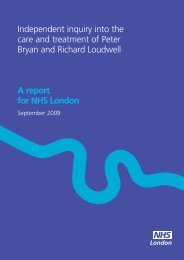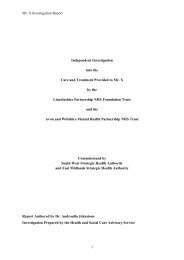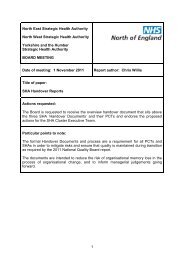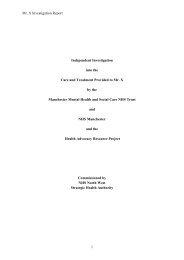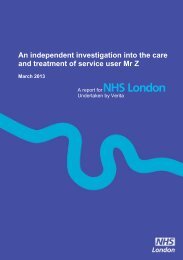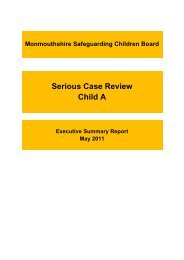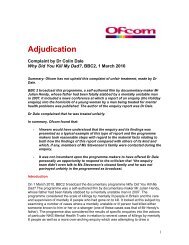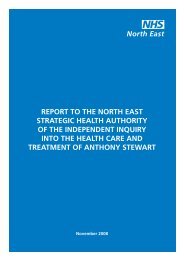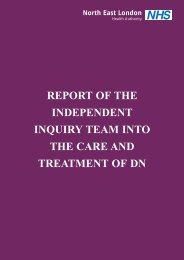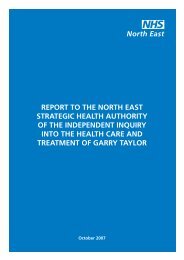Lousia Ovington independent investigation report ... - NHS North East
Lousia Ovington independent investigation report ... - NHS North East
Lousia Ovington independent investigation report ... - NHS North East
Create successful ePaper yourself
Turn your PDF publications into a flip-book with our unique Google optimized e-Paper software.
CHAPTER 5 – INVOLVEMENT WITH POLICE AND PROBATION<br />
100<br />
the offender may cause serious harm to the public. The guidance goes on to say<br />
that the responsibility for identifying category 3 offenders lies with the agency<br />
‘that initially deals with them’.<br />
The Responsible Authority for the locality will have established a unit to run MAPPA<br />
for the area and set out referral procedures. (Durham/Darlington’s public protection<br />
unit, a product of a joint police and probation initiative, was established in 1999).<br />
Management of MAPPA - once accepted and placed in categories 1, 2 or 3, an<br />
offender subject to MAPPA is managed at one of three levels. While the assessed level<br />
of risk is an important factor, it is the degree of management intervention required<br />
which determines the level.<br />
Level one: involves normal agency management. Generally offenders managed at this<br />
level will be assessed as presenting a low or medium risk of serious harm to others and<br />
it is only suitable where risks can be managed by one agency 85 .<br />
Level two: local inter agency risk management, through a process of formal meetings<br />
with permanent representatives of crucial agencies which have a role to play in risk<br />
management and others as necessary, in a process that is dynamic, i.e., that changes<br />
to suit the circumstances of the offender. Most offenders subject to this level are<br />
assessed as high or very high risk of harm. 86<br />
Level three: known as Multi-Agency Public Protection Panels (or MAPPPs). This level is<br />
appropriate for the ‘critical few’ - those offenders who pose the highest risk of causing<br />
serious harm, whose management is so problematic that multi-agency co-operation<br />
and oversight at a senior level is required with the authority to commit exceptional<br />
resources, or who are exceptional as a result of media scrutiny/public interest. 87<br />
Good risk assessment involves those undertaking it being prepared to actively<br />
investigate the offender’s circumstances and background, to ensure that they have all<br />
relevant information and to take the time to evaluate it thoroughly. MAPPA enables<br />
and promotes this, resulting in more effective supervision and better public protection.<br />
The guidance 88 recognises that the evaluation of risk is a dynamic, not a static process;<br />
therefore if an offender is subject to MAPPA, any changes in risk profile can be<br />
managed.<br />
Management of risk can take many different forms, for example regular visits by<br />
police, referrals to forensic services for assessment, assistance with housing.<br />
85 In 2004/05 about 71% of MAPPA offenders were managed at this level.<br />
86 In 2004/05 about 25% of MAPPA offenders were managed at this level.<br />
87 In 2004/05 about 3% of MAPPA offenders were managed at this level.<br />
88 MAPPA Guidance Probation



